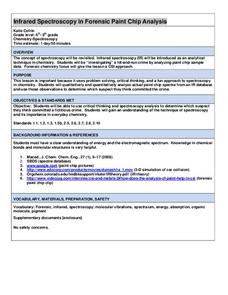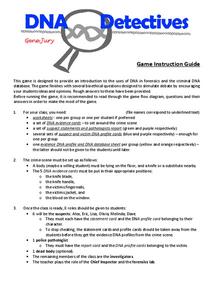Curated OER
Fingerprint Identification 2
In this forensic science worksheet, students examine and identify the fingerprint pattern of 12 fingerprint samples. They classify them as arch, whorl or loop.
Curated OER
Hair Test
In this forensic science worksheet, students write an open response to 3 short answer questions on hair evidence collected at the crime scene.
Curated OER
Hair Test
In this forensic science worksheet, students write an essay about 3 open response questions presented about hair evidence shown on the photo.
Curated OER
Hair Test
In this forensic science worksheet, students write an open response to 1 question about hair evidence collected from the crime scene.
Curated OER
Hair Test
In this forensic science worksheet, students write an open response to 2 questions about a picture of hair evidence collected from the crime scene.
Curated OER
Hair Test
In this forensic science instructional activity, high schoolers write an open response to 1 question on hair evidence photo taken from the crime scene.
Curated OER
Hair Test
For this forensic science worksheet, students write an open response to 3 questions posed about hair evidence in the crime scene. They explain where and why the samples are most likely found.
Curated OER
Fingerprint Identification 3
In this forensic science worksheet, students identify 12 fingerprint marks. They classify them according to the pattern made.
Curated OER
Fingerprint Identification 4
For this forensic science worksheet, students identify 16 fingerprints according to its type. They classify them as either whorl, loop or arch.
Curated OER
Using Blood Tests to Identify Babies and Criminals
Students solve a crime by matching a suspect's blood type to physical evidence collected at the crime scene. For this forensic science lesson, students identify the different blood types. They explain how blood tests work.
Curated OER
Infrared Spectroscopy in Forensic Chip Analysis
Students analyze spectrums as related to forensics. In this chemistry lesson, students define spectroscopy and discuss its use in chemistry. They discuss how the Forensic Paint Chip is used to help solve crimes.
Curated OER
Who Did It?
Students explore how forensic science is used in criminal investigations. They learn that for the next few days that are going to try to solve a crime that took place in the classroom. Students are given a story to read about the crime...
Columbus City Schools
Thinking Like A Soil Scientist
Ready to roll up those sleeves and get your hands dirty? Dirty with soil science content, that is! Overcome those "But it's just dirt" objections with a trip outside to collect soil samples for some in-class analysis. Use the variety of...
Gene Jury
DNA Detectives
Police find a man murdered in a local hotel, DNA everywhere, and now they need scholars' help. Budding detectives step into a crime scene playing the roles of victim, suspects, and investigators. They apply knowledge of criminology and...
Curated OER
Who Is It?/Who Done It?
Students conduct an experiment that allows them to assess individual differences in random DNA sequences and apply those differences when solving a forensic problem. After discussing the polymerase chain reaction and its use to identify...
Curated OER
Flesh Eating Bugs, Moldy Corpses, The Trail of a Killer
Learners read about how forensic entomologists use maggots to solve murders. In this forensic science lesson, students read an article and answer questions. They go to different websites about evidence and fingerprinting.
Curated OER
The Science of Forensics
Middle schoolers examine the importance of details in evidence gathering, as well as the relationship between chemistry, physics and biology. In this forensics lesson plan students divide into groups and look at fingerprints and fill...
Curated OER
Confectionary Bureau of Investigations: Case of the Cookie Mystery
Students perform tests on different chemicals to determine their chemical properties. In this forensic science lesson, students identify an unknown sample using its physical and chemical properties. They solve a fictional crime using...
Curated OER
CSI, Second Grade Style
Second graders conduct a classroom investigation. In this investigative lesson, 2nd graders spend their time observing, measuring, and collecting data. They simulate a forensic science lab by conducting a fingerprint, scent, footprint,...
Curated OER
DNA AND BLOOD TYPING
Students list three descriptive characteristics and three functions of DNA, describe two ways that genetics is important in a forensic investigation, and list the four major human blood types.
Curated OER
Trace Evidence
In this trace evidence worksheet, students use the websites on the forensic science page of the kid zone at http://sciencespot.net/ to complete the fill in the blank questions on the worksheet.
Curated OER
Forest Forensics
Pupils explore forests. In this "forest forensic" lesson students divide into groups and go through the stations using their clues to solve the questions.
Curated OER
Aviation History/Writing and Forensic Science
In this aviation lesson, students research Charles Augustus Lindbergh and other early aviators and their flying machines. They then write a letter to one of the aviators asking questions about the mechanics of flight and their flying...
Curated OER
Murder Mystery
High schoolers examine how to capture foot prints while they simulate a criminal investigation. They discover how the clues are needed for identifying or eliminating murder suspects.
Other popular searches
- Forensic Science Powerpoint
- Forensic Science Project
- Forensic Science Blood Type
- Vocabulary Forensic Science
- Forensic Science Lab
- Forensic Science Power Point
- Forensic Science Activities
- Forensic Science Fingerprint
- History of Forensic Science
- Forensic Science Entomology
- Forensic Science Archaeology
- Forensic Science Archeology

























